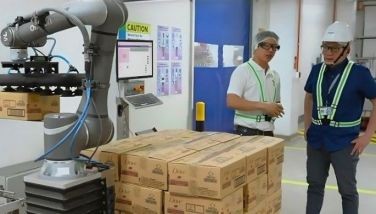CLSU machine can pelletize goat food
MANILA, Philippines - A machine that can make make goat feeds into pellets has been developed.
The gadget was designed and fabricated by Dr. Armando Espino of the Central Luzon State University (CLSU) in the Science City of Muños, Nueva Ecija.
The pelleting machine is expected to help ensure the continuous availability of high-protein, low-cost feeds of goats by using the surplus during the wet months as material for pelleted total mixed ration(TMR).
A pelleted TMR is a mixture of napier, ipil-ipil, rice bran, copra meal, molasses, discaphos, ranzoni, and salt, a complete nutrient food for goats. With it, goats are assured better food efficiency and greater starch digestibility.
As it is, the feed supply of goats is deficient during the lean months from mid-October to April.
The palletizing machine was made “to ensure a year-round feed supply for goats,” said Dr. Edgardo Orden, regional coordinator of the Research and Development Program for Sustainable Goat Enterprise in Central Luzon.
Dr. Orden explained that feed supply of goats largely affects the shift of feeding from natural to pelleted TMR.
“Feeds are abundant during the rainy season but is scarce during the dry months. To sustain the feed supply of goats, appropriate forage materials can be stored for a longer period through palletizing the feeds,” he said.
He added that production of pelleted forage feeds can be a viable option for entpreneurs so that they can cater to the needs of livestock raisers.
Turning the forage into pellets is an arduous process involving the transformation of a soft feed into pellets through compression, extrusion, and adhesion in the palletizing machine. Before these steps, the raw materials should be milled and ground.
The end product is pelleted TMR, longer than one inch. They are dense and durable enough to withstand mechanical handling without compromising the diet’s nutritional value.
Dr. Orden reported that the machine can produce 150-200 kilogram per hour when palletizing pure rice bran. However, when using TMR as raw material, the production rate would decrease to about 60 kg/hr.
“This is due to the high fiber content of TMR, which makes the palletizing process more difficult,” he explained.
The machine can operate at two to three hours per day.
The ruminant expert further said that the principal advantage of pelleted TMR is that it has longer shelf life and includes less feed wastes.
Dr. Orden concluded: “It is through the production of pelleted TMR that a sustainable goat enterprise could be achieved since feeding the goats with sufficient nutrition is not seasonal anymore but year-round.” – Rudy A. Fernandez
- Latest























